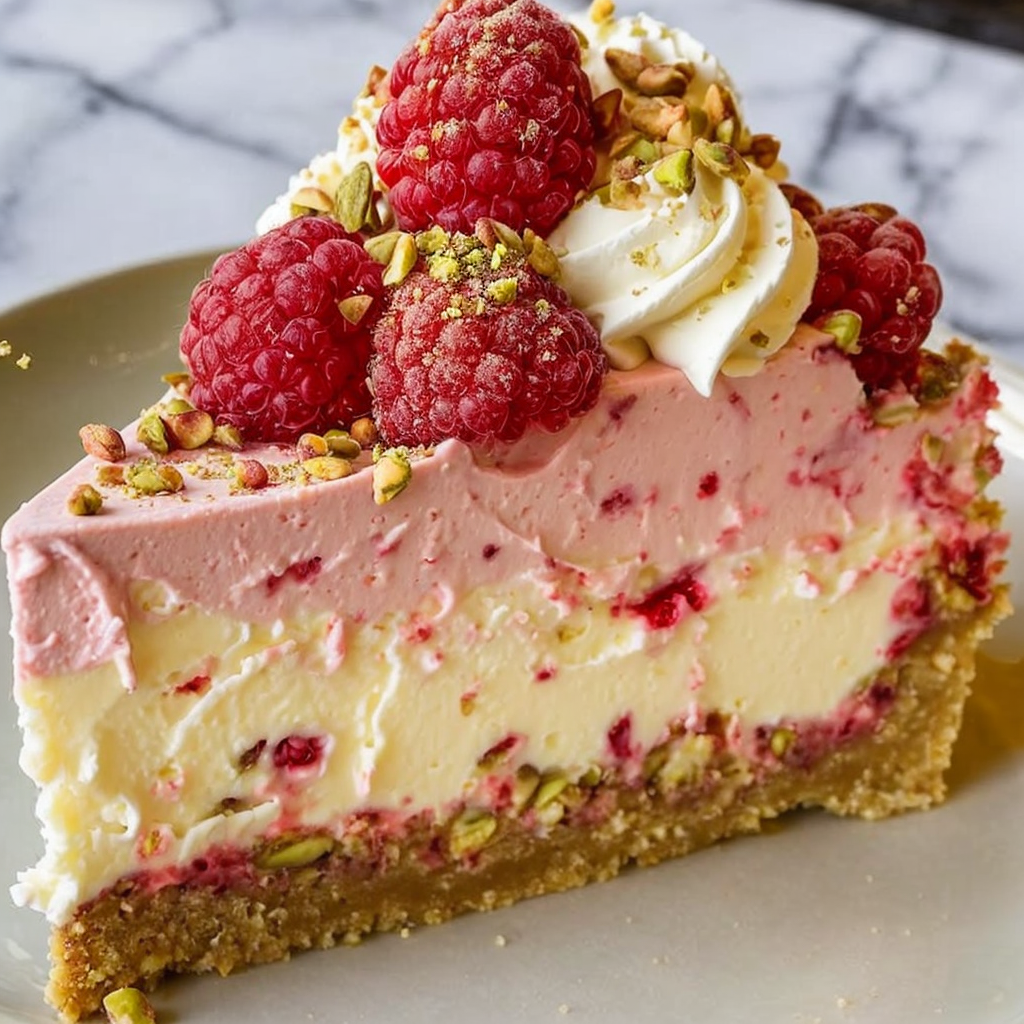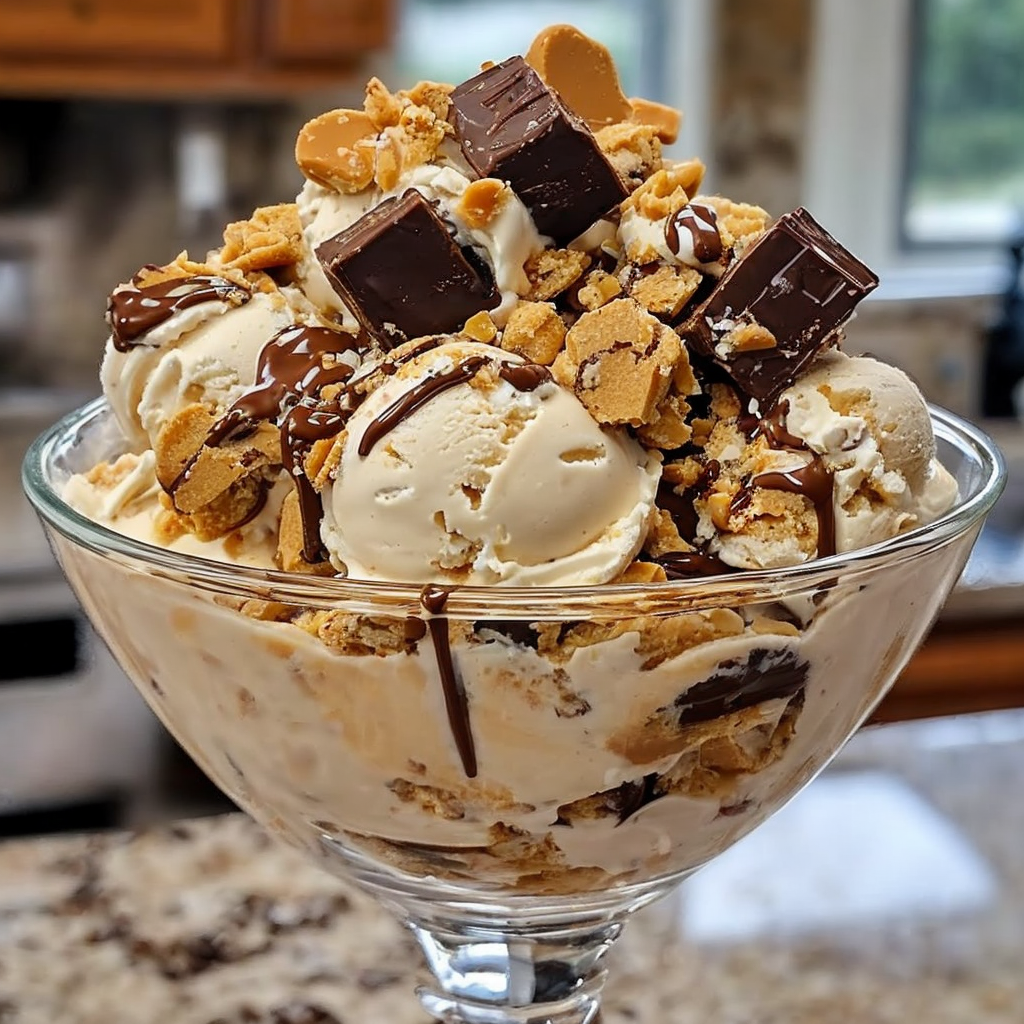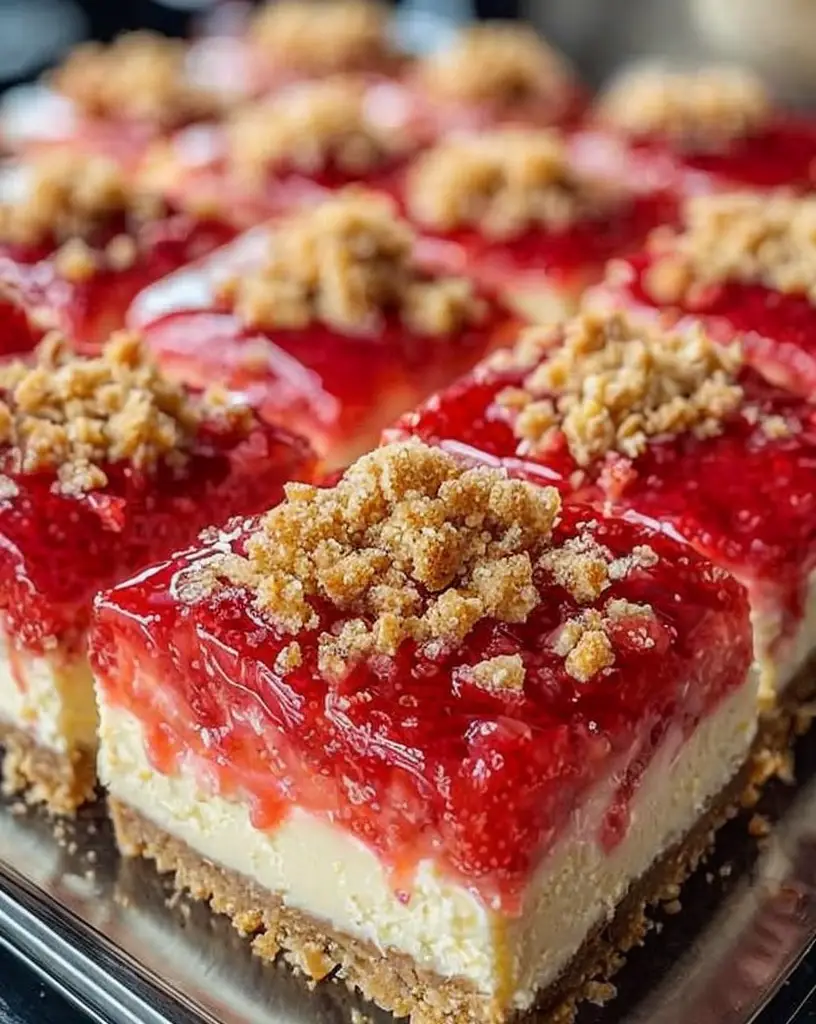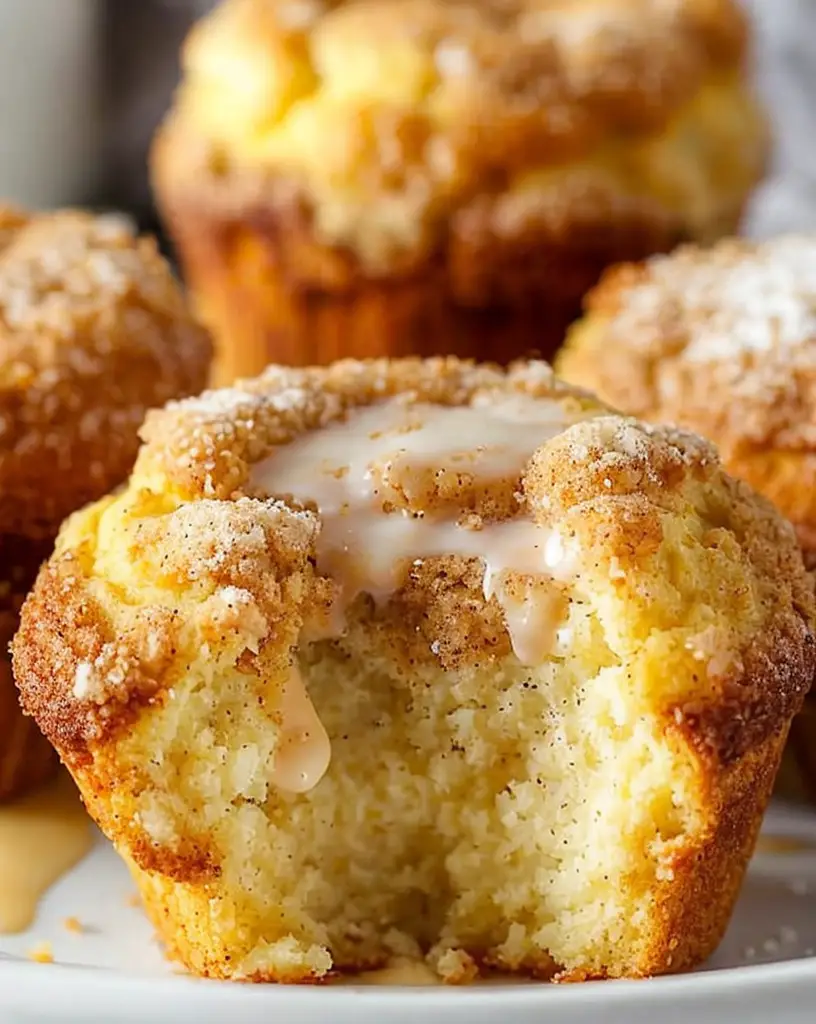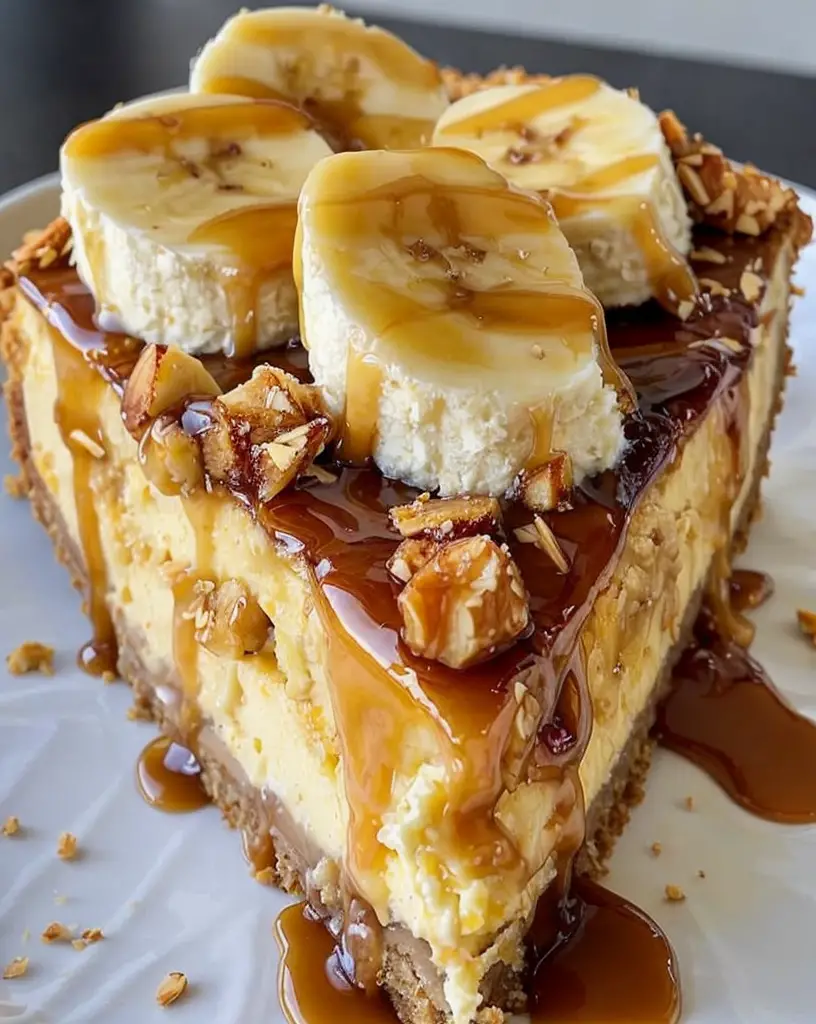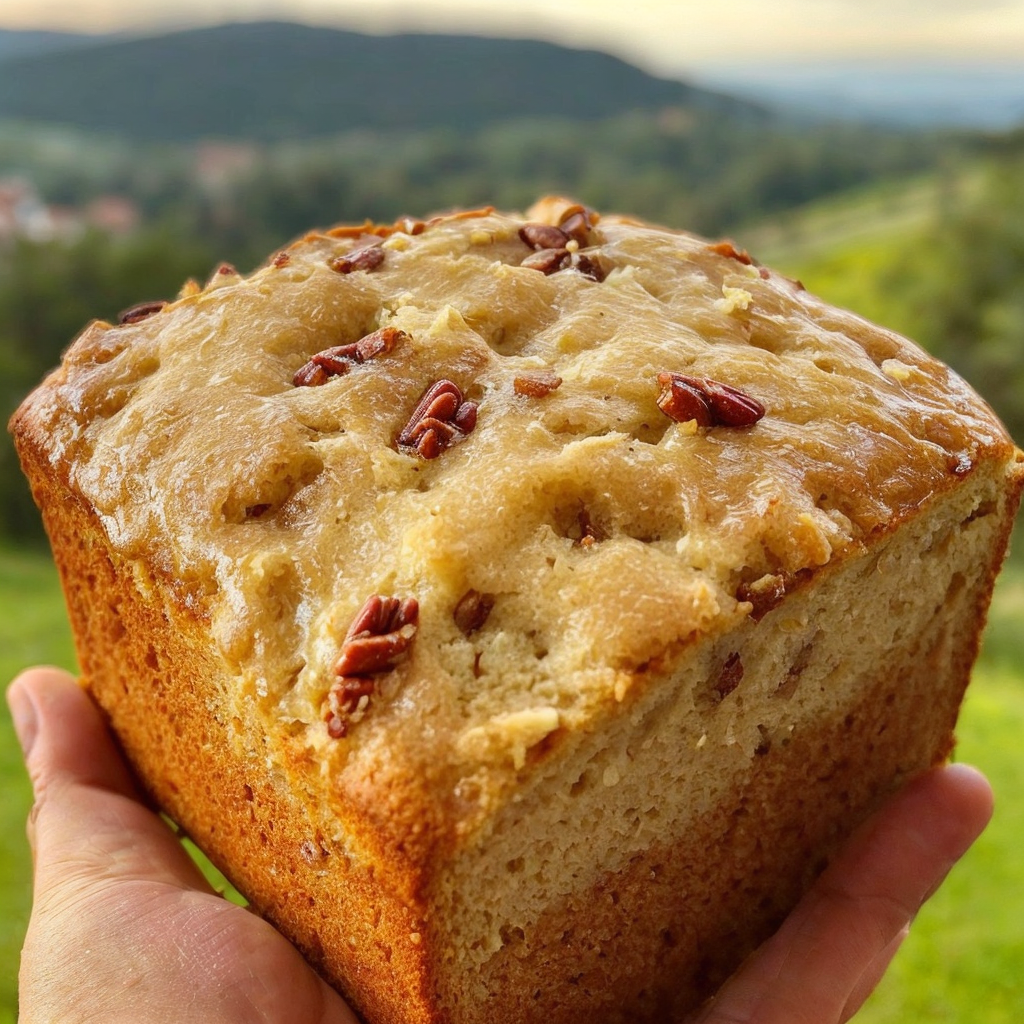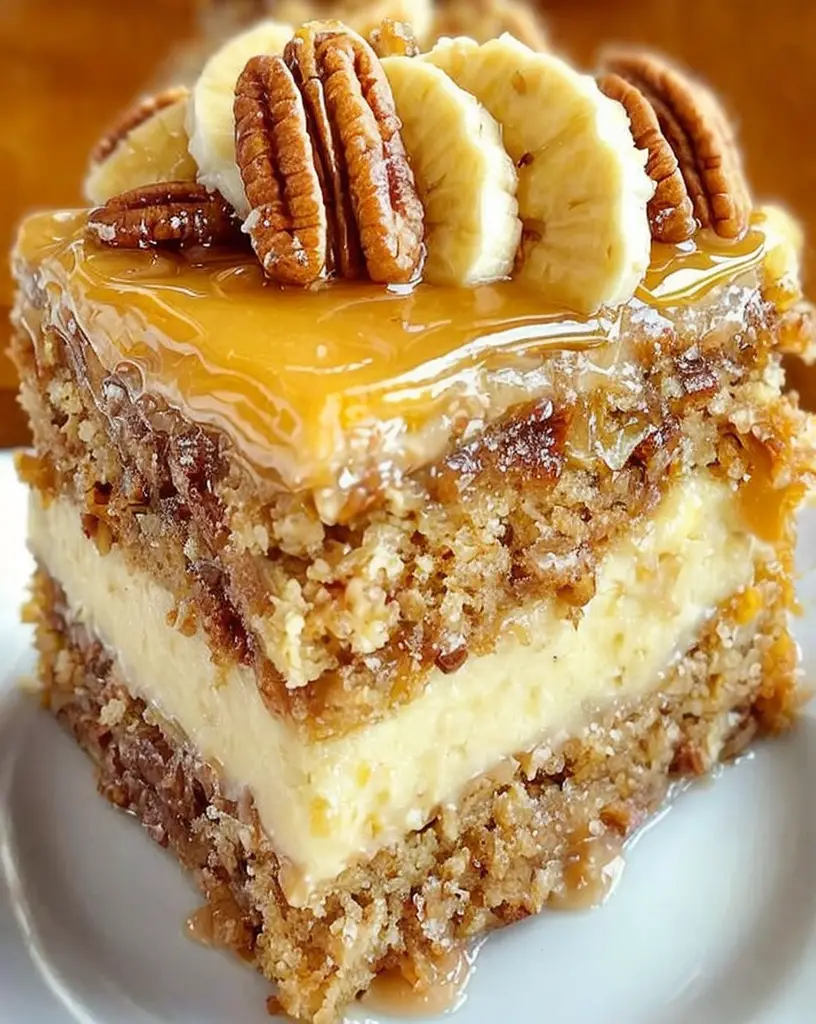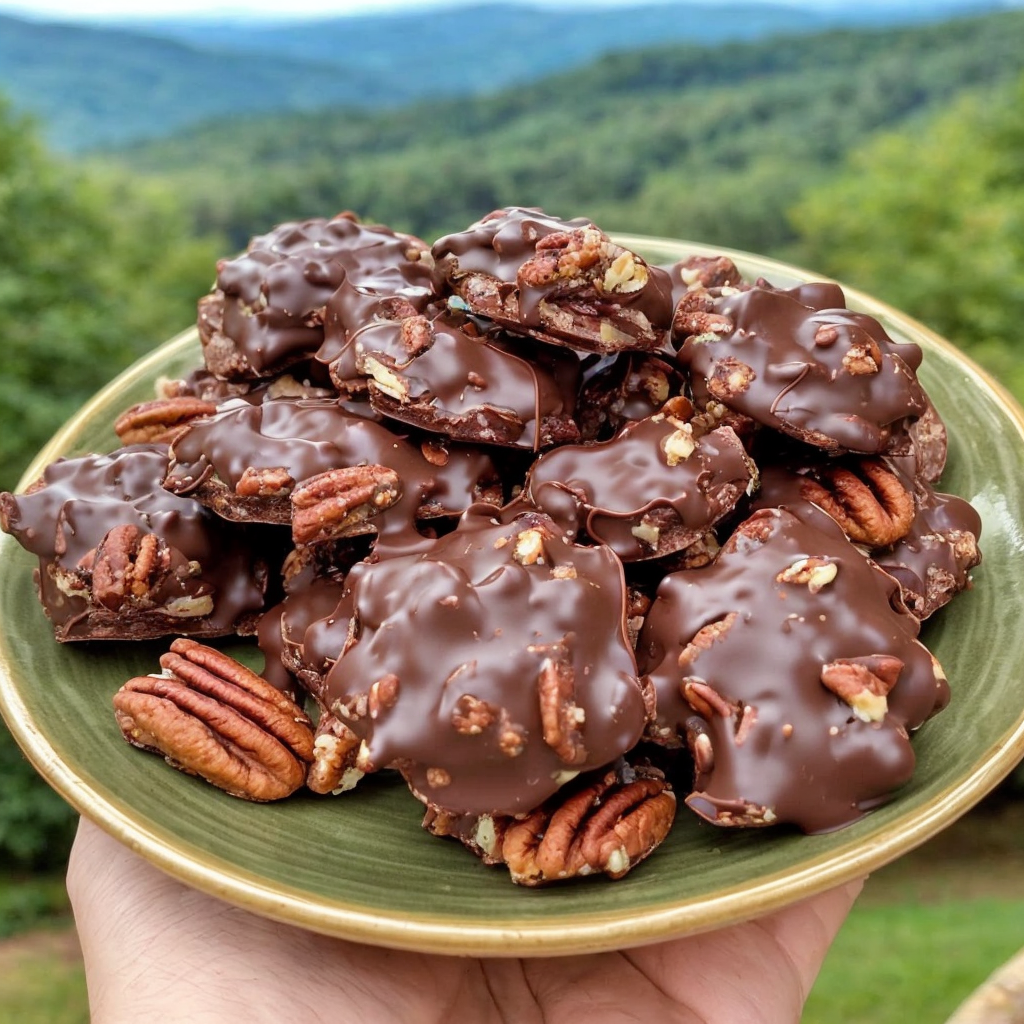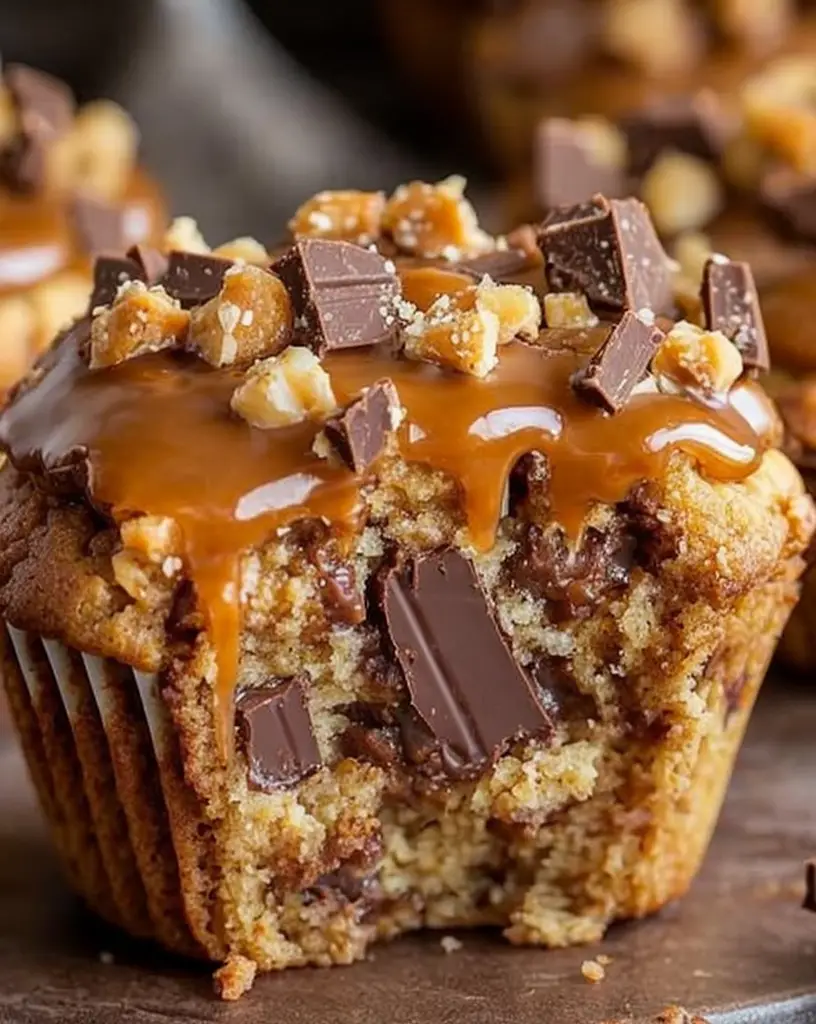Celebrate Your Special Moments with Our Raspberry Pistachio Cheesecake
Indulge your senses in the decadence of our Raspberry Pistachio Cheesecake. This exquisite dessert harmoniously blends the tangy burst of raspberries with the rich, nutty goodness of pistachios, encapsulated in a creamy, velvety cheesecake. Perfect for birthdays, anniversaries, or any celebratory occasion, this cake promises to be a show-stopping centerpiece that will delight your guests, leaving them craving for more. The balance of flavors and textures makes it a memorable dessert worth savoring.
Quick Recipe Highlights
- Flavor Profile: This cheesecake is a delightful symphony of tangy raspberries contrasted with the naturally sweet, earthy flavor of pistachios, making each bite a gourmet experience.
- Texture: Enjoy the creamy, rich texture of cheesecake against the slightly crunchy bite of pistachio, perfectly complemented by a luscious raspberry swirl.
- Aroma: A beautiful medley of nutty pistachios and fresh, fragrant raspberries will tantalize your senses from the moment the dessert is sliced.
- Visual Appeal: With its stunning green and red layers, accented by vibrant raspberry swirls, this cheesecake is as much a feast for the eyes as it is for the palate.
- Skill Level Needed: While this recipe demands a moderate level of expertise, it rewards with a bakery-quality finish that impresses and satisfies.
- Special Equipment: A springform pan and a food processor are essential tools in achieving the perfect crust and seamless blending of ingredients.
Recipe Overview
- Difficulty Level: This recipe is categorized as intermediate due to its multiple steps and precise baking techniques, yet it remains accessible to anyone with a passion for baking.
- Category: Positioned in the dessert category, this cheesecake is an ideal choice when you need a stunning sweet treat for luxurious dinners or celebrations.
- Cuisine: Combining elements from both European and Middle Eastern cuisines, this dessert introduces a fusion of flavors highlighting the versatility of cheesecake.
- Cost: With pistachios and fresh raspberries, this decadent dessert involves a moderate cost but guarantees high-end flavor satisfaction.
- Season: Best enjoyed in spring and summer when raspberries are freshest and most flavorful, though it remains a year-round favorite with frozen substitutes.
- Occasion: Reserve this cheesecake for weddings, holiday gatherings, or anniversaries where its opulent look and taste enhance the celebratory mood.
Why You’ll Love This Recipe
Taste and texture are at the heart of this Raspberry Pistachio Cheesecake’s appeal. Each slice offers a luxurious mouthfeel, where the smooth, creamy cheesecake is contrasted by the nuanced crunch of pistachios. The sweet-tart raspberries add a touch of bright flavor that cuts through the richness, making it a harmonious blend that your palate will appreciate.
Convenience is also a highlight, as the cheesecake can be prepared in sections ahead of time, easing the stress of last-minute preparations. With the use of a water bath technique, the baking process ensures an irresistibly creamy texture without cracking, even for novice bakers.
Nutritionally, this dessert offers a delightful indulgence with healthful aspects, as pistachios are full of heart-healthy fats and proteins, while raspberries provide antioxidants. Serving this dessert is not only a treat for taste buds but also provides some nutritional benefits.
The social aspect is inherent in its presentation; one can’t help but be impressed by the visual allure of the cheesecake, making it a conversational centerpiece when entertaining guests. Each slice served generates interest and compliments, making your event memorable.
Cost-effectiveness adds to the charm of this recipe. Considering the sophisticated flavor profile it offers, the ingredients are relatively accessible, and economical in bulk, allowing for indulgence without financial strain.
Historical Background and Cultural Significance
The ubiquity of cheesecakes dates back to ancient times when it was said that the Greeks served them to their Olympic athletes. As a beloved dessert across the globe, it has gone through numerous adaptations and renditions based on regional ingredient availability and preferences.
Culturally, the combination of raspberry and pistachio caters to a variety of taste buds, capturing the essence of European desserts’ elegance and the rich, heartfelt tradition of Middle Eastern sweets. It serves as a symbol of culinary globalization, marrying diverse flavor profiles.
Over time, the recipe has evolved to include varying cheesecake bases, from graham cracker to almond meal, each iteration bringing a unique character to the dessert. Modern innovations have led to the introduction of whimsical adaptations like this raspberry pistachio version, broadening the cheesecake’s appeal.
Regionally, you’ll find variations that incorporate local fruits and nuts, emphasizing the adaptability of cheesecake to incorporate seasonal and cultural ingredients. This enables food enthusiasts to explore and create a version that speaks uniquely to their taste while preserving the dessert’s classic roots.
Ingredient Deep Dive
Raspberries, rich in antioxidants, not only deliver a vibrant color but also provide the tartness needed to balance the cheesecake’s sweet creaminess. Choosing the freshest berries results in superior taste, while frozen can work in off-seasons. Store them dry in the fridge for longevity.
Pistachios, treasured in both savory and sweet dishes, offer a distinct buttery flavor with a hint of sweetness. Beyond culinary delight, they prose heart-healthy benefits due to their monounsaturated fat content. Opt for unsalted to maintain control over the dessert’s overall flavor profile.
Cream cheese is the pillar of any cheesecake, delivering the luscious texture that defines this dessert. Look for full-fat versions to achieve the richness this recipe demands. Storing cream cheese properly and bringing it to room temperature before use prevents lumps.
Graham crackers serve as the traditional base, providing a sweet, crumbly foundation. Alternatively, try digestive biscuits for a touch of malt flavor. Pulse them into crumbs for an even crust, combining with melted butter until it achieves the desired consistency.
Common Mistakes to Avoid
- Overmixing the batter can introduce air bubbles, resulting in a cracked surface post-bake.
- Skipping the water bath may cause uneven baking, leading to a dry center or burnt edges.
- Using cold ingredients leads to a lumpy batter; room temperature is ideal for smooth mixing.
- Undercooking the pistachio crust can lead to sogginess; ensure a firm base by monitoring baking time.
- Neglecting the cooling process may cause the cheesecake to collapse; gradual temperature reduction is key.
- Substituting low-fat cream cheese changes texture, making it less creamy and more rubbery.
- Forgetting to strain raspberry sauce leads to a seed-filled experience, detracting from overall taste.
- Inadequate chilling time before serving can result in a soft, less-structured cheesecake slice.
Essential Techniques
A crucial step in cheesecake success is mastering the water bath technique. This method prevents cracking by ensuring even baking, as the surrounding water maintains a consistent temperature around the cheesecake. Wrap the springform pan securely in foil to prevent water seepage.
Properly folding whipped cream into the batter is another technique to perfect for a light, airy texture. Use a gentle hand, slowly folding, ensuring the whipped cream maintains its volume without deflating. The result? An elegantly smooth and luscious consistency.
Pro Tips for Perfect Raspberry Pistachio Cheesecake
Toast pistachios before incorporating them into your crust for a heightened flavor profile that enhances their natural nutty undertone.
Combine lemon zest into the cheesecake batter for an extra depth of taste that complements the raspberry’s tartness subtly and beautifully.
Use a high-speed blender to purée raspberries for a silky-smooth sauce that integrates seamlessly into the cheesecake filling or for drizzling atop each slice.
Allow the cheesecake to cool slowly in the oven with the door slightly ajar for an hour before transferring it to the refrigerator. This prevents cracking by minimizing the sudden change in temperature.
Presentation is key, so garnish with whole raspberries and crushed pistachios just before serving to create a visually striking effect that tastes as good as it looks.
When slicing, a warm knife ensures clean cuts; run it under hot water, then dry before each incision to maintain a polished presentation without cheesecake sticking.
Variations and Adaptations
For a regional twist, incorporate rosewater into the raspberry layer to infuse Middle Eastern floral notes, enhancing the pistachio’s presence for a richer profile.
Adapt this dessert seasonally by substituting the raspberries with lingonberries for a Nordic approach, lending more bite and tartness to the creamy backdrop.
Create a dietary-friendly version by opting for gluten-free graham crackers in the crust and ensuring all other ingredients are cross-contamination free.
Amplify flavor in the cheesecake by swirling in a fresh raspberry reduction instead of whole berries, allowing for a more integrated, concentrated taste.
Modify the texture by employing smooth ricotta in combination with cream cheese for a lighter, fluffier result that has a slightly different mouthfeel, catering to diverse preferences.
Give your dessert a modern flair by crafting miniature cheesecakes in ramekins, allowing for personalized servings that highlight the dish’s exquisite presentation.
Serving and Presentation Guide
Artful plating is pivotal in boosting a cheesecake’s appeal. Consider serving slices on contrasting dark plates, where the vibrant raspberry and pistachio colors truly stand out.
Garnish extravagantly with a scattering of whole raspberries and a sprinkle of powdered sugar for a snow-kissed effect, adding a sophisticated touch to each slice.
Accompany with a dollop of whipped cream or a scoop of vanilla bean ice cream, complementing the cheesecake’s richness with a light, airy contrast.
Experiment with temperature by serving the cheesecake slightly chilled for a firmer slice or allow it to sit out briefly for a creamier texture that envelops each forkful.
Maintain portion control by utilizing a ring mold to serve consistent, beautifully edged portions that speak to fine dining aesthetics during your gathering.
Add a personal touch with edible flowers like violets for whimsical garnishing that infuses natural elements into the presentation, enticing guests visually and gastronomically.
Wine and Beverage Pairing
For wine lovers, pair this opulent cheesecake with a sweet Moscato or a sparkling Rosé, complementing its fruity, nutty complexity harmoniously.
Non-alcoholic alternatives like a chilled raspberry herbal tea or an elderflower cordial can match the refreshing notes, offering layers of floral and berry flavors.
If coffee is your preference, an espresso or a lightly sweetened American coffee balances the richness of the cheesecake with its naturally bold, bitter profile.
Consider balanced temperature when serving; for example, a cold Moscato accentuates the creamy coolness of the cheesecake, enhancing the tasting experience.
Opt for serving suggestions that align with dessert wines in smaller glasses, allowing guests to enjoy the complementary pairing in a refined, tasteful manner.
Storage and Shelf Life
Store the cheesecake in its springform pan, wrapped tightly in plastic wrap to maintain freshness and prevent the absorption of external odors in the refrigerator.
Kept chilled, the cheesecake can last up to five days, providing ample opportunity to savor leftovers while maintaining quality.
When seeking to extend shelf life, consider freezing. Wrap slices individually in parchment before sealing in an airtight container or freezer bag.
Recognize spoilage signs such as off smells or visible changes in color or texture. When reheating, a brief stay in the microwave restores the desired consistency.
Freezing guidelines suggest doing so only after the cheesecake is thoroughly chilled, as sudden temperature shifts may alter its texture.
Make Ahead Strategies
To streamline preparation, crust and filling can be made ahead separately, stored in the fridge overnight, and assembled just before baking.
Between steps, ensure stored components remain covered and refrigerated to maintain optimal freshness, avoiding moisture loss, or flavor degradation.
Assess the cheesecake’s quality when preparing in advance, as it benefits from a chilling period, allowing flavors to marry and achieve ideal consistency.
During assembly, focus on layering neatly to preserve the aesthetic quality that draws admiration, especially for the intricate raspberry swirls.
Follow rehearsing guidelines carefully to achieve the desired textured outcome, considering brief thawing for frozen portions before serving.
Supplement fresh elements such as raspberries or garnish only when ready to serve, as this ensures they remain vibrant and fresh.
Scaling Instructions
To halve this recipe, adjust all ingredient quantities proportionally and consider using a smaller pan to ensure even baking without compromising texture.
Doubling involves meticulous attention to measurements, as overfilling can lead to baking inconsistencies; a larger baking pan or multiple pans may be required.
Equipment adjustments might include utilizing additional mixing bowls or larger food processor capacity to manage increased ingredient quantities efficiently.
When considering cooking times, closely monitor for doneness signs, as larger cakes may require longer baking; adjust based on the achieved golden color and texture.
Storage considerations include ensuring scaled portions fit within available container space and remain organized for easy access and freshness maintenance.
Nutritional Deep Dive
This Raspberry Pistachio Cheesecake offers a balanced macro breakdown providing carbohydrates from the crust, proteins from nuts, and fats from the cream cheese.
Micronutrient analysis highlights significant contributions from raspberries’ vitamin C and pistachios’ potassium and B6 content.
Health benefits include cardiovascular support from pistachios and antioxidant properties of raspberries, contributing to a wholesome dessert profile.
Dietary considerations cater to indulgence, mindful of portion control and caloric intake, especially when cheesecake is part of a balanced meal plan.
Portion analysis advises keeping slice sizes moderate, as the cheesecake is rich, ensuring enjoyment without overwhelm.
For weight management tips, pair a reduced slice with fresh fruit or include as part of a calorie-calculated meal plan.
Dietary Adaptations
For a gluten-free alternative, choose gluten-free graham crackers and double-check all other ingredients and substitute accordingly.
Dairy-free modifications may involve substituting traditional cream cheese with a cashew-based equivalent or coconut cream for an innovative touch.
Create a vegan version by exploring vegan cream cheese and plant-based butter alternatives, maintaining deliciousness with ethical consciousness.
Adjust to a low-carb dessert diet by using almond flour for the crust and employing sugar substitutes carefully within baking requirements.
Ensure all ingredients align with a keto lifestyle by integrating higher fat substitutes and sweeteners like erythritol within compositions.
Modify to fit a paleo-friendly diet by integrating almond meal crusts and natural sweeteners, ensuring the cheesecake aligns with your nutritional goals.
Satisfy a low-FODMAP dietary need by ensuring each ingredient remains compliant with personal guidelines, focusing on ingredient quality and safety.
Troubleshooting Guide
Address texture issues by ensuring accurate measurements and proper incorporation of wet and dry elements to achieve desired creaminess.
Balance flavors by tasting raspberry reduction for sweetness or tartness adjusting with sugar or lemon juice as necessary.
Combat temperature problems by preheating ovens fully and using reliable thermometers for accuracy throughout the baking process.
Overcome equipment challenges where substitutions for springform pans might involve lined cake tins with proper containment of batter.
Navigate ingredient substitutions with care, focusing on maintaining texture and flavor as closely as possible when accommodating dietary needs.
Timing concerns can be rectified by setting timers at key intervals, ensuring baking is not interrupted prematurely or allowed excessive cooking.
Recipe Success Stories
Join our community of food lovers who have collectively experienced the joy of this Raspberry Pistachio Cheesecake. Each rendition brought a unique twist, from swapping raspberries for blueberries to celebrating a national holiday.
Readers have shared their adaptations, with many highlighting the smooth, creamy consistency achieved through careful attention to mixing techniques and ingredient handling.
Variations have included additions such as mascarpone for extra richness or crumb bases utilizing seasonal shortbreads for those wanting a bespoke flavor.
Photographs from our culinary enthusiasts capture brilliant colors, showcasing individual flair in garnishing through sliced pistachios and twisting raspberry sauces.
Experimentation suggestions have ranged from integrating a hint of cardamom for a warm, spicy balanced note to utilizing walnut crusts for a softer bite.
Frequently Asked Questions
Can I freeze Raspberry Pistachio Cheesecake?
Freezing is possible and recommended for preserving your cheesecake. Wrap slices individually to maintain quality, especially for long-term storage.
How do I avoid a cracked cheesecake top?
Employ the water bath method, ensuring even baking and avoiding overmixing air into the batter, as air bubbles trapped are often culprits of cracks.
What are some eggless options?
Explore alternatives like silken tofu, agar-agar, or flax eggs to replace traditional eggs while maintaining the integrity and texture of your bake.
What if my crust is soggy?
Baking your crust long enough and cooling it thoroughly before adding filling assists in firming its structure, reducing soggy results.
How can I make the cake denser?
Increase cheese content or reduce whipped elements in the batter for a firmer, richer texture that keeps shape more rigidly.
Are there nut-free crust options?
Try a classic graham cracker base or use cookie alternatives that exclude nuts to cater to specific dietary requirements or allergies.
Best way to swirl raspberry sauce?
Spoon sauce onto the cheesecake and use a knife or skewer to create intricate swirls gently, preventing complete inclusion for visible aesthetics.
Is a bain-marie necessary?
While not essential, it’s strongly recommended to produce a cheesecake with a smooth, crack-free finish due to uniform cooking temperatures.
How long to refrigerate before serving?
Post-bake, chill your cheesecake for a minimum of four hours, overnight refrigeration ensures it’s completely set for optimal serving presentation.
What if I over-whipped my batter?
If your batter’s whipped excessively, gentle folding can incorporate it back into manageable consistency, reducing any unwanted airiness.
Can I opt for a flavored crust?
Absolutely, experiment with flavored digestive or chocolate biscuits that complement your cheesecake filling, enriching the overall dessert experience.
How adaptable is this cheesecake recipe?
It’s highly flexible, promoting ingredient exchanges and substitutions within maintaining structure, supporting numerous dietary guidelines easily.
Additional Resources
Peruse our curated selection of related recipes that complement your Raspberry Pistachio Cheesecake artistry, offering synergistic ingredients and topping inspirations.
Delve into comprehensive technique guides, focusing on essential cheesecake-making skills such as perfecting water baths and preserving fresh fruits.
Explore ingredient information, highlighting the optimal selection and pairing of raspberries and pistachios, securing your bakery-inspired cheesecake results.
Access equipment recommendations ensuring central kitchen tools — from springform pans to blenders — enhance your capacity for creative explorations.
Consider seasonal variations and adaptations, helping harness the bounties of nature throughout the year for your cheesecake creations.
Join the Conversation
Engage with our community by sharing your Raspberry Pistachio Cheesecake endeavors through social media platforms such as Instagram or Facebook, catching and sharing your masterpiece with like-minded foodies.
Deliver exquisite photography with tips on effective plating captured through your lens, making your meticulous creation look as tantalizing as it tastes.
Offer insightful recipe reviews and reflections, documenting your cheesecake adventure step-by-step to inspire readers considering a similar culinary venture.
Encourage community engagement through feedback or alternative recommendations, fostering discussions highlighting common improvements or shared culinary knowledge.
Explore personalized recipe variations, fostering diverse interpretations that continue evolving beyond initial conceptions, contributing to rich culinary heritage.
The Recipe
Raspberry Pistachio Cheesecake
Serves: 8
Prep Time: 30 mins
Cook Time: 60 mins
Total Time: 90 mins
Kitchen Equipment Needed
- 9-inch springform pan
- Food processor
- Mixing bowls
- Hand mixer
- Measuring cups and spoons
- Rubber spatula
- Bain-marie setup (large enough baking dish for the water bath)
Ingredients
- 1 1/2 cups graham cracker crumbs
- 1/2 cup unsalted pistachios, toasted
- 1/3 cup melted butter
- 24 oz cream cheese, softened
- 1 cup sugar
- 3 large eggs
- 1 tsp vanilla extract
- 1 cup fresh raspberries
- 2 tbsp lemon juice
- 1/4 cup confectioner’s sugar for raspberry sauce
- Additional pistachios and raspberries for garnish
Directions
- Preheat your oven to 325°F (160°C). Wrap the outside of a 9-inch springform pan with aluminum foil to prevent water seepage.
- In a food processor, pulse graham cracker crumbs and toasted pistachios until fine. Add melted butter and pulse until combined.
- Press the crust mixture evenly into the bottom of the prepared springform pan. Bake for 10 minutes and let it cool.
- In a large bowl, beat the cream cheese and sugar together until smooth. Incorporate eggs one at a time, mixing until just blended, then stir in vanilla extract.
- Pour half the batter over the cooled crust. Swirl in some of the raspberry sauce made by blending raspberries, lemon juice, and confectioner’s sugar until smooth.
- Top with remaining batter and additional raspberry swirls. Place the pan into a bain-marie and bake for 50-60 minutes or until the center is set.
- Once baked, turn off the oven and let the cake cool in the oven with the door ajar for one hour to prevent cracks. Refrigerate for at least four hours or overnight.
- When ready to serve, top with extra raspberries and chopped pistachios. Slice with a warm knife for clean presentation.
Recipe Notes
- Substitute graham crackers with digestive biscuits if preferred.
- Ensure raspberries are well blended for smoother swirls.
- Chilling thoroughly enhances flavor melding and texture solidification.
- Adjust lemon juice to balance desired tartness in raspberry sauce.
